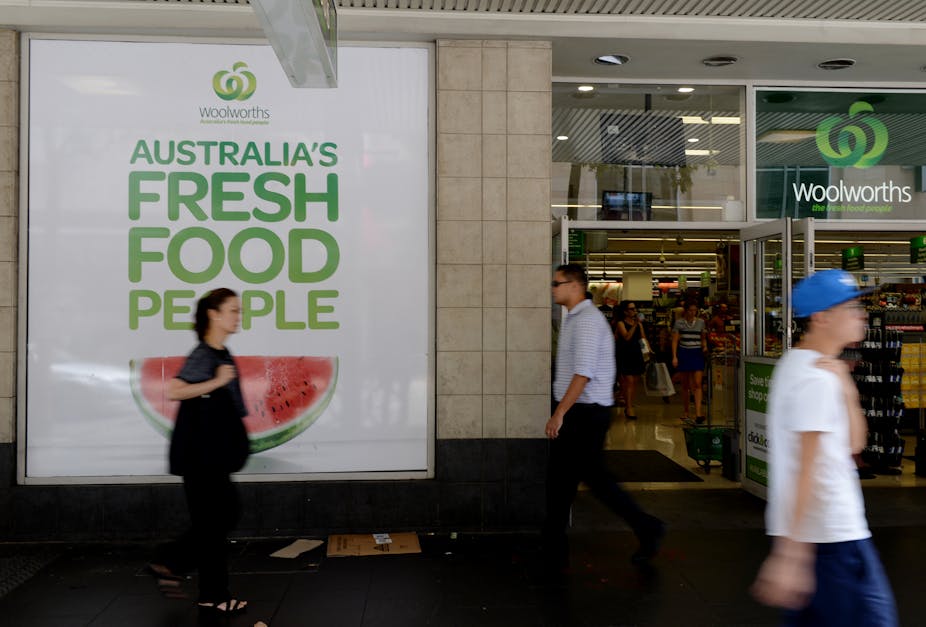In their bids for greater market share, Australia’s two largest supermarket chains sometimes portray themselves as healthy places to shop. But Woolworths’ latest “Jamie’s Garden” sticker campaign might be about more than just promoting fruit and vegetables.
The use of collectables (such as stickers and cards) has been fabulously successful for Australian supermarkets, with Woolworths’ previous Aussie Wildlife and DreamWorks Heroes cards a huge hit with kids nationwide.
But the supermarket chain has hit a snag with its latest high-profile fruit and vegetable-focused campaign. The promotion itself is not the problem, with its expertly produced sticker books and recipe cards boasting clear health promotion credentials.
What has caused a stir for the company is the fact that it’s charging fruit and vegetable growers 40 cents per crate in advertising fees during the campaign. The assumption seems to be that the company will sell so much extra fruit and veg that it’s only fair for the farmers to contribute too.
But growers are questioning why they should be footing the bill for a campaign that will benefit the supermarket chain more than them. So is the campaign genuinely about selling more fruit and veg, or is it more about profits and market share?
Supermarkets as health food stores?
The theatre of supermarkets means fruit and veg are often the first thing we see on entering a store. The reality, though, is that a huge amount of shelf space is devoted to foods outside the five main food groups, which are known as discretionary foods.

Prime promotional sites at checkouts, end-of-aisle displays and island bins are far more likely to contain soft drinks, chips, confectionery and chocolate than fruit and vegetables. And they’re highly effective.
A recent study of end-of-aisle displays in UK supermarkets illustrates how position can have profound effects on what people purchase. It showed that placing soft drinks at the end of aisles increased their sales by 52%.
International comparisons have confirmed that Australian supermarkets have more end-of-aisle and checkout displays devoted to chips, chocolate, confectionery and soft drinks than stores in seven other developed countries.
And this emphasis on junk food extends to catalogues, where the majority of food and drinks advertised are also “discretionary foods”. So, while supermarkets like to spruik their health-food credentials, the reality is that, through the unhealthy foods they promote, they’re also making a contribution to Australia’s obesity epidemic.
Collectables and consumption
A 2009 review on the relationship between sales promotions and overall food consumption patterns identified that:
practically no attention has been paid to the impacts of sales promotions on dietary behaviours or to how they could be used more effectively to promote healthy eating.
Most available research relates to price discounts that have clear and unsurprising effects on purchasing in the short term. Whether marketing promotions without price discounts have any impact on eating habits in the longer term (after the campaign has ended) is highly doubtful, particularly for perishable foods, such as fruit and vegetables.
This makes it hard to have much confidence that Woolworths’ latest fruit and vegetable-focused collectables campaign will make a huge difference to children’s eating habits, especially in the longer term.

Nevertheless, from a public health perspective, it is encouraging to see a child-focused campaign targeting healthy food – a rare thing indeed in the world of food marketing to children.
The likely real agenda
So this latest campaign is clearly not just about fruit and veg sales. We can safely speculate that the supermarket chain’s primary motivation is to increase profits – as it is for most businesses.
The most likely result of such campaigns is to increase market share and boost customer loyalty. While there’s no published research on this specifically, most parents of school-aged children can attest to the effectiveness of a strategy targeting children’s love of collectables.
Once customers are through the supermarket door, the fact that the sticker book is all about fruit and vegetables becomes mostly irrelevant. They’re exposed to the heavy marketing of discretionary foods that Australian supermarkets do so well. It’s increasing sales of all foods, not just fruits and vegetables, that’s the ultimate goal.
With this in mind, farmers may be quite right to feel aggrieved at having to dig deep to fund what at first glance appears to be a campaign all about fruit and veg.
Major supermarkets are ideally placed to encourage healthy eating across the whole population. And promotions that encourage healthy options must be applauded. But until supermarkets also reduce their relentless promotion of unhealthy foods, it remains hard to believe they truly have the health of the population at heart.

